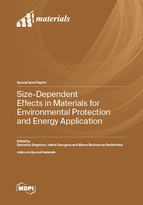Size-Dependent Effects in Materials for Environmental Protection and Energy Application
A special issue of Materials (ISSN 1996-1944). This special issue belongs to the section "Materials Chemistry".
Deadline for manuscript submissions: closed (31 October 2023) | Viewed by 21331
Special Issue Editors
Interests: solid state chemistry; materials for energy storage; lithium ion batteries; sodium ion batteries; electron paramagnetic resonance spectroscopy; structure characterization; intercalation chemistry
Special Issues, Collections and Topics in MDPI journals
Interests: theoretical and computational chemistry; molecular modeling; molecular and periodic structures; spectroscopis properties; optical materials
Interests: oxide glasses; structural characterization; thermal stability; optical properties; sol–gel synthesis; hybrid materials; photocatalytic properties; antibacterial properties
Special Issue Information
Dear Colleague,
The concept of size-dependent material properties becomes dominant in the materials science community. Understanding the size-dependent properties of materials is the most challenging issue in the advanced Materials science. To a great extent this is a result of the technological requirements concerning the development of materials with controlled properties, as well as of the recent progress in materials science, nanotechnology and computational chemistry.
The aim of this Special Issue is to discuss the dimensional effects in materials for environmental protection and clean energy production as an innovative approach for the development of innovative materials with improved properties. The Special Issue will comprise (but is not limited to) the following three main classes of advanced inorganic materials that form the basis of modern technologies:
- Materials and thin films for environmental protection;
- Materials for clean energy storage;
- Ceramics/Bioceramics and Glasses for Better Living (with applications in optics, molecular electronics and medicine).
Prof. Dr. Radostina Stoyanova
Prof. Dr. Ivelina Georgieva
Dr. Albena Bachvarova-Nedelcheva
Guest Editors
Manuscript Submission Information
Manuscripts should be submitted online at www.mdpi.com by registering and logging in to this website. Once you are registered, click here to go to the submission form. Manuscripts can be submitted until the deadline. All submissions that pass pre-check are peer-reviewed. Accepted papers will be published continuously in the journal (as soon as accepted) and will be listed together on the special issue website. Research articles, review articles as well as short communications are invited. For planned papers, a title and short abstract (about 100 words) can be sent to the Editorial Office for announcement on this website.
Submitted manuscripts should not have been published previously, nor be under consideration for publication elsewhere (except conference proceedings papers). All manuscripts are thoroughly refereed through a single-blind peer-review process. A guide for authors and other relevant information for submission of manuscripts is available on the Instructions for Authors page. Materials is an international peer-reviewed open access semimonthly journal published by MDPI.
Please visit the Instructions for Authors page before submitting a manuscript. The Article Processing Charge (APC) for publication in this open access journal is 2600 CHF (Swiss Francs). Submitted papers should be well formatted and use good English. Authors may use MDPI's English editing service prior to publication or during author revisions.
Keywords
- advanced inorganic materials
- chemistry of materials
- computational chemistry
- catalysts/sorbents
- electrode materials for rechargeable batteries
- hydrogen storage materials
- glasses and ceramics
- optics
- molecular electronics
- bio-compatible materials









